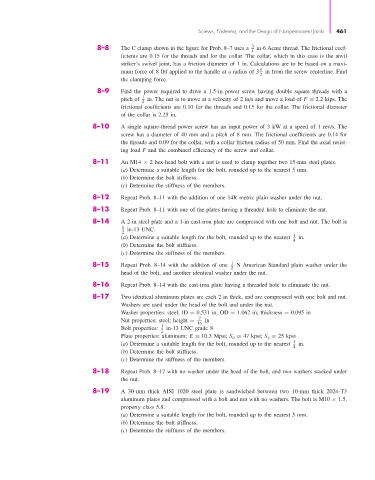Page 486 - Shigley's Mechanical Engineering Design
P. 486
bud29281_ch08_409-474.qxd 12/16/2009 7:11 pm Page 461 pinnacle 203:MHDQ196:bud29281:0073529281:bud29281_pagefiles:
Screws, Fasteners, and the Design of Nonpermanent Joints 461
8–8 The C clamp shown in the figure for Prob. 8–7 uses a 3 4 in-6 Acme thread. The frictional coef-
ficients are 0.15 for the threads and for the collar. The collar, which in this case is the anvil
striker’s swivel joint, has a friction diameter of 1 in. Calculations are to be based on a maxi-
mum force of 8 lbf applied to the handle at a radius of 3 1 2 in from the screw centerline. Find
the clamping force.
8–9 Find the power required to drive a 1.5-in power screw having double square threads with a
pitch of 4 1 in. The nut is to move at a velocity of 2 in/s and move a load of F = 2.2 kips. The
frictional coefficients are 0.10 for the threads and 0.15 for the collar. The frictional diameter
of the collar is 2.25 in.
8–10 A single square-thread power screw has an input power of 3 kW at a speed of 1 rev/s. The
screw has a diameter of 40 mm and a pitch of 8 mm. The frictional coefficients are 0.14 for
the threads and 0.09 for the collar, with a collar friction radius of 50 mm. Find the axial resist-
ing load F and the combined efficiency of the screw and collar.
8–11 An M14 × 2 hex-head bolt with a nut is used to clamp together two 15-mm steel plates.
(a) Determine a suitable length for the bolt, rounded up to the nearest 5 mm.
(b) Determine the bolt stiffness.
(c) Determine the stiffness of the members.
8–12 Repeat Prob. 8–11 with the addition of one 14R metric plain washer under the nut.
8–13 Repeat Prob. 8–11 with one of the plates having a threaded hole to eliminate the nut.
8–14 A 2-in steel plate and a 1-in cast-iron plate are compressed with one bolt and nut. The bolt is
1 in-13 UNC.
2
(a) Determine a suitable length for the bolt, rounded up to the nearest 1 4 in.
(b) Determine the bolt stiffness.
(c) Determine the stiffness of the members.
8–15 Repeat Prob. 8–14 with the addition of one 1 2 N American Standard plain washer under the
head of the bolt, and another identical washer under the nut.
8–16 Repeat Prob. 8–14 with the cast-iron plate having a threaded hole to eliminate the nut.
8–17 Two identical aluminum plates are each 2 in thick, and are compressed with one bolt and nut.
Washers are used under the head of the bolt and under the nut.
Washer properties: steel; ID = 0.531 in; OD = 1.062 in; thickness = 0.095 in
7
Nut properties: steel; height = 16 in
Bolt properties: 1 2 in-13 UNC grade 8
Plate properties: aluminum; E = 10.3 Mpsi; S u = 47 kpsi; S y = 25 kpsi
(a) Determine a suitable length for the bolt, rounded up to the nearest 1 4 in.
(b) Determine the bolt stiffness.
(c) Determine the stiffness of the members.
8–18 Repeat Prob. 8–17 with no washer under the head of the bolt, and two washers stacked under
the nut.
8–19 A 30-mm thick AISI 1020 steel plate is sandwiched between two 10-mm thick 2024-T3
aluminum plates and compressed with a bolt and nut with no washers. The bolt is M10 × 1.5,
property class 5.8.
(a) Determine a suitable length for the bolt, rounded up to the nearest 5 mm.
(b) Determine the bolt stiffness.
(c) Determine the stiffness of the members.

